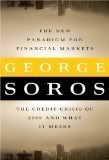 I finally finished reading George Soros : The New Paradigm for Financial Markets over the weekend, and I enjoyed it tremendously. The book is divided into two parts. The first part is about Soros’ philosophy and how it applies to the finance sector, and the second is about Soros’ views about the future of the global economy and financial markets. I will likewise split my review of the book into two parts, the first part will recap and review Soros’ views of the financial markets, and the second part will discuss his views on the global economy.
I finally finished reading George Soros : The New Paradigm for Financial Markets over the weekend, and I enjoyed it tremendously. The book is divided into two parts. The first part is about Soros’ philosophy and how it applies to the finance sector, and the second is about Soros’ views about the future of the global economy and financial markets. I will likewise split my review of the book into two parts, the first part will recap and review Soros’ views of the financial markets, and the second part will discuss his views on the global economy.
Soros believes that the equilibrium theory of traditional economics is fundamentally flawed, a result of a social science trying fruitlessly to achieve the determinate predictions of the natural sciences. He believes that human behavior is fundamentally unpredictable. The very act of studying human behavior produces knowledge that, once widely assimilated by the public, may invalidate the original study. Using the financial markets as an example, he attributes the collapse of many of the recent financial products to their basis in equilibrium theory. Traditional theory holds that the prices of financial instruments reflect the underlying fundamentals, and deviations from equilibrium prices take the form of a random walk around equilibrium prices. Soros argues that financial markets are not typically in equilibrium, and are more often trending under a prevailing bias. While excessive price movements not supported by fundamentals are often corrected, in certain cases, movements in the prices of financial products directly affect the underlying fundamentals, creating feedback loops resulting in booms and busts. For example, real estate booms in the US (in the 2000s) and Japan (in the 1980s) took place because increased lending by banks caused an increase in real estate values, which in turn made such lending seem safer and more profitable, causing yet more lending, until finally the only requirement for a mortgage loan is the ability to breathe. A similar phenomenon can also occur using equity instruments. During the Vietnam War, share prices of defense contractors went through the roof while those of conventional companies sunk. After the war, CEOs of major defense contractors quickly realized that the enormous earnings growth that occurred during the war cannot be sustained, and that their stocks are now over-valued. They responded by using their over-valued shares to purchase the under-valued conventional companies, which resulted in an acceleration of earnings growth, which in turn caused their share prices to further rise, which made possible additional acquisitions. The defense contractors ended up building huge conglomerates and achieving stratospheric stock prices, and the public became infatuated with the new conglomerate sector. Companies could raise enormous amounts of capital simply by declaring the intention to make acquisitions. However, earnings growth inevitably slowed as the conglomerates became too big, and the nitty-gritty details of assimilating companies proved too much for several conglomerates, and the entire sector came crashing down. Feedback loops work both on the upside and on the downside.
Soros argues that credit expansion, whether through debt or equity, is inherently unstable because of their feedback characteristics. As prices fluctuate, a random spike will trigger the positive feedback loop and become the start of a boom. As such, Soros believes that all credit markets should be carefully regulated, not only banks. He does not believe that the markets are able to accurately price risk when left alone. Even intelligent players in the market who recognize the dangers involved are compelled to play the game due to short-term pressures from shareholders and peer companies. Soros cites the example of Chuck Prince, former CEO of Citigroup, who made the following now-infamous comment in July 2007 :
“When the music stops, in terms of liquidity, things will be complicated. But as long as the music is playing, you’ve got to get up and dance. We’re still dancing.”
Soros sees himself as practising reality-based investing, as opposed to other investors who practise theory-based investing. He focuses on where prices are heading, as opposed to where they should be.
I find Soros to be an interesting hybrid between a short-term trader and a long-term investor. He is a short-term investor because he typically takes short-term positions based on the current trend, yet his positions are based on analysis of the fundamentals, which in his case is typically a combination of macroeconomic conditions and the current market psychology. His description of his many years in Wall Street makes for an interesting read, and his grasp of macroeconomics issues is very impressive, and certainly far superior to mine. At this time a year ago, when the defaults in subprime mortgages were just beginning to trend upwards, I thought that the problem will be contained, simply because subprime mortgages make up a small portion of the total pool of mortgages. Soros recognized that the subprime crisis is only a catalyst, and that the event will prompt investors to re-evaluate all mortgages, and that this would lead to a reversal of the feedback loop. He had previously stopped personally managing his money, but came back from retirement to readjust the portfolios of all his money managers, imposing net-short US stocks rules, as well as creating a macro fund which shorted the US dollar. He ended up with an excellent return for 2007. His book also details his real-time trading decisions for the first 3 months of 2008, which ended with him being down a bit. Overall, I find the book interesting and thought provoking.
